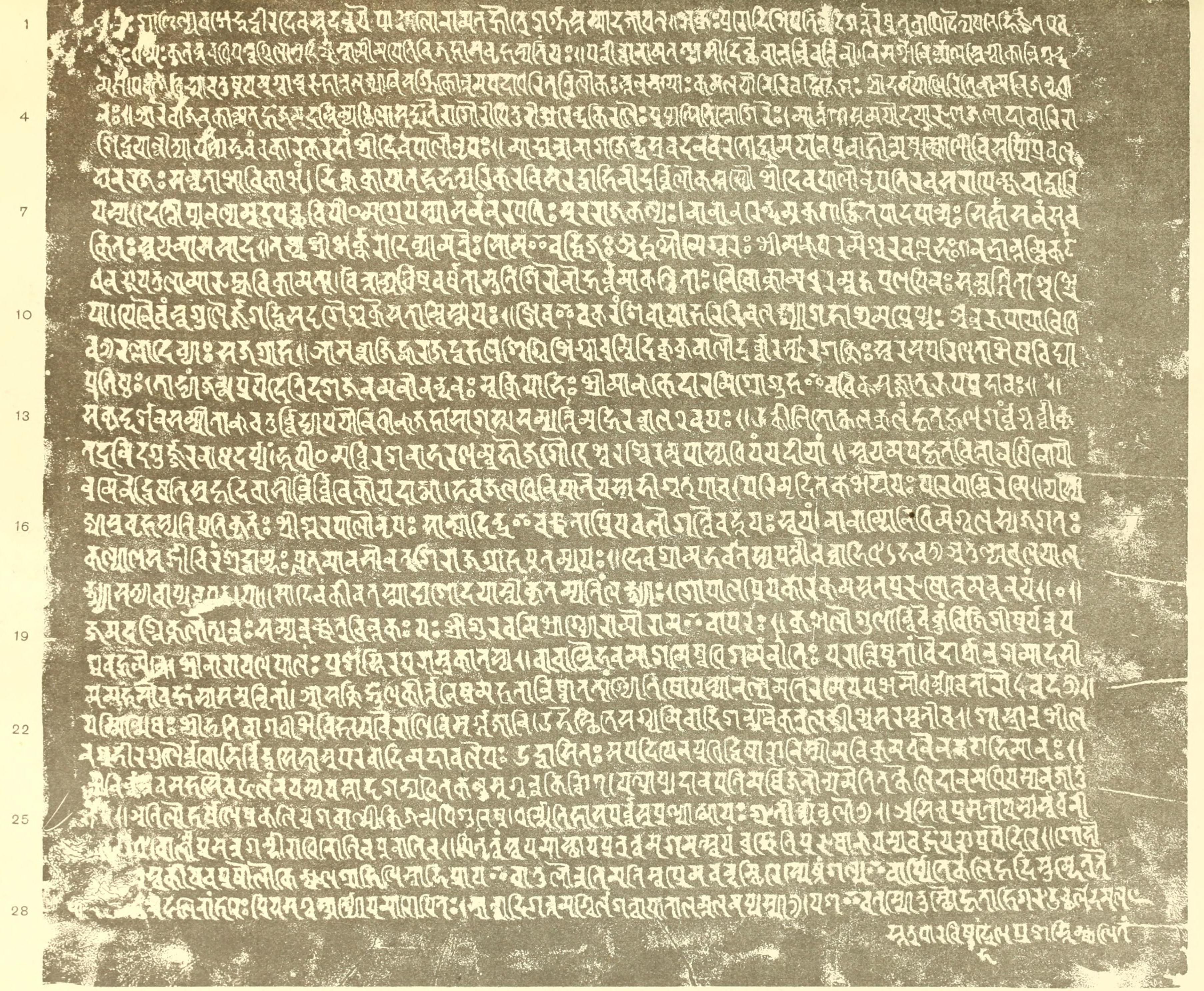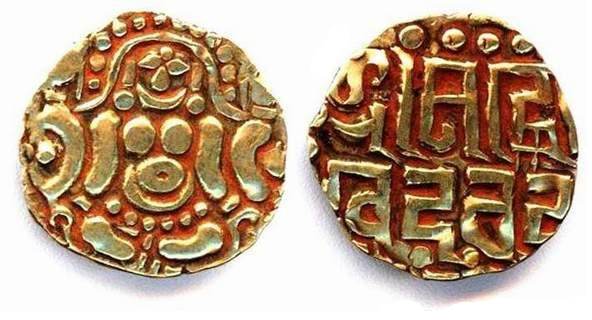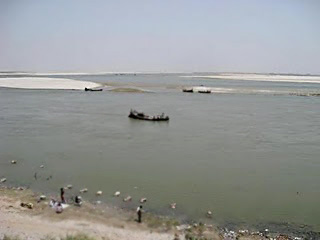|
Ramapala
Ramapala (r. 1077–1130 CE) was the successor to the Pala king Shurapala II in the Bengal region of the Indian subcontinent, and fifteenth ruler of the Pala line. Early life Ramapala was the youngest son of Vigrahapala III. His mother was an unknown Rashtrakuta princess. Ramapala showed valour in battle field during the reign of his father, according to Manhali copper plate. Ramapala, along with his older brother Shurapala II, was locked in a bitter struggle with their oldest brother Mahipala II, who ascended the Pala throne after their father's death. They were imprisoned by Mahipala. However, after Mahipala's death at the hands of Kaivarta chief Divya, the brothers fled to distant parts of their kingdom, where they succeeded one another. Shurapala ruled for two years, before being succeeded by Ramapala. Reign and military career Varendra Rebellion At the very beginning, Ramapala reigned over a small territory comprising part of Magadha and Radha. But soon, according to ... [...More Info...] [...Related Items...] OR: [Wikipedia] [Google] [Baidu] |
Pala Emperor
The Pāla Empire was the empire ruled by the Pala dynasty, ("protector" in Sanskrit) a medieval Indian dynasty which ruled the kingdom of Gauda. The empire was founded with the election of Gopāla by the chiefs of Gauda in late eighth century CE. The Pala stronghold was located in Bengal and eastern Bihar, which included the major cities of Gauḍa, Vikramapura, Pāṭaliputra, Monghyr, Somapura, Ramavati (Varendra), Tāmralipta and Jagaddala. The Pālas were astute diplomats and military conquerors. Their army was noted for its vast war elephant corps. Their navy performed both mercantile and defensive roles in the Bay of Bengal. At its zenith under emperors Dharmapala and Devapala in the early ninth century, the Pala empire was the dominant power in the northern Indian subcontinent, with its territory stretching across the Gangetic plain to include some parts northeastern India, Nepal and Bangladesh. Dharmapala also exerted a strong cultural influence through Buddhis ... [...More Info...] [...Related Items...] OR: [Wikipedia] [Google] [Baidu] |
Pala Empire
The Pāla Empire was the empire ruled by the Pala dynasty, ("protector" in Sanskrit) a medieval Indian dynasty which ruled the kingdom of Gauda Kingdom, Gauda. The empire was founded with the election of Gopala, Gopāla by the chiefs of Kingdom of Gauda, Gauda in late eighth century CE. The Pala stronghold was located in Bengal and eastern Bihar, which included the major cities of Gauḍa (city), Gauḍa, Bikrampur, Vikramapura, Pataliputra, Pāṭaliputra, Munger, Monghyr, Somapura, Ramavati (Varendra), Tamralipta, Tāmralipta and Jaggadala, Jagaddala. The Pālas were astute diplomats and military conquerors. Their army was noted for its vast war elephant corps. Their navy performed both mercantile and defensive roles in the Bay of Bengal. At its zenith under emperors Dharmapala (emperor), Dharmapala and Devapala (Pala dynasty), Devapala in the early ninth century, the Pala empire was the dominant power in the northern Indian subcontinent, with its territory stretching across ... [...More Info...] [...Related Items...] OR: [Wikipedia] [Google] [Baidu] |
Kumarapala (Pala King)
Kumarapala (Bengali : কুমারপাল) was the successor to the Pala king Ramapala in the Bengal region of the Indian subcontinent, and sixteenth ruler of the Pala line reigning for 10 years. During his reign, he put down an uprising in Kamarupa by the governor Timgyadeva, eventually replacing him with Vaidyadeva (who would rebel four years after the death of Kumarapala). He was succeeded by his son Gopala IV, who ascended the throne as a child. Biography Kumarapala, one of Ramapala’s three sons, took the throne after his father, as his other son Rajyapala had died earlier. During Ramapala’s reign, the kingdom faced serious internal problems as well as attacks from neighboring rivals. One of these adversaries was Govindachandra of the Gahadavala dynasty, who managed to defeat Ramapala’s forces in battle. In an effort to ease tensions, Ramapala’s uncle, Mathanadeva, tried to make peace by arranging a marriage between his granddaughter, Kumaradevi, and Govind ... [...More Info...] [...Related Items...] OR: [Wikipedia] [Google] [Baidu] |
Shurapala II
Shurapala II (r. 1075–1077) was a ruler of the Pala Empire in the Eastern regions of the Indian subcontinent. He was the successor to the Pala king Mahipala II and fourteenth ruler of the Pala line, reigning for at least two years. He, along with his younger brother, were locked in a bitter struggle with their elder brother Mahipala II, and were imprisoned. After Mahipala's defeat at the hands of Kaivarta chief Divya they escaped to East Bengal. R.D. Banerji states that silence of ''Ramacharitam'' about the death of Shurapala indicates that Shurapala was murdered by Ramapala, although R.C. Majumdar disagrees with this claim. He was succeeded by his younger brother Ramapala. See also *List of rulers of Bengal This is a list of rulers of Bengal. For much of History of Bengal, its history, Bengal was split up into several independent kingdoms, completely unifying only several times. In Kingdoms of Ancient India, ancient times, Bengal consisted of the ... References ... [...More Info...] [...Related Items...] OR: [Wikipedia] [Google] [Baidu] |
Vigrahapala III
Vigrahapala III (1041–1067 CE) was the successor to the Pala king Nayapala in the Bengal region of the Indian subcontinent, and twelfth ruler of the Pala line. He was succeeded by Mahipala II. During the reign of Vigrahapala III, the Kalachuri king Karna once again invaded Bengal but was defeated. The conflict ended with a peace treaty, and Vigrahapala III married Karna's daughter Yauvanasri. Vigrahapala III was later defeated by the invading Chalukya armies of Someshvara I led by his son, the future Vikramaditya VI. The invasion of Chalukyas saw several soldiers from South India into Bengal, which explains the southern origin of the Sena Dynasty of Bengal & the Karnata dynasty of Mithila. Vigrahapala III also faced another invasion led by the Somavamsi king Mahasivagupta Yayati of Orissa. Subsequently, a series of invasions considerably reduced the power of the Palas. The Varmans occupied eastern Bengal during his reign. The emergent Sena dynasty seized Radha from the Pa ... [...More Info...] [...Related Items...] OR: [Wikipedia] [Google] [Baidu] |
Mahipala II
Mahipala II was the successor to the Pala king Vigrahapala III in the Bengal region of the Indian subcontinent, and thirteenth ruler of the Pala line reigning for six years. He was succeeded by Shurapala II. Mahipala II was locked in a bitter conflict with his ambitious younger brothers, Surapala and Ramapala. He imprisoned them early in his reign. The common people were also oppressed during his rule. Mahipala had to face a well-organised rebellion of his vassal chiefs. Mahipala’s army was small and ill-equipped, but he advanced to fight the rebels. He was defeated and killed by the rebels under the leadership of Divya. The rebels occupied the capital, and Surapala and Ramapala fled the city. See also *List of rulers of Bengal This is a list of rulers of Bengal. For much of History of Bengal, its history, Bengal was split up into several independent kingdoms, completely unifying only several times. In Kingdoms of Ancient India, ancient times, Bengal consisted of the ... [...More Info...] [...Related Items...] OR: [Wikipedia] [Google] [Baidu] |
Govindachandra (Gahadavala Dynasty)
Govindachandra (IAST: Govindacandra, 1114–1155 CE) was the King of Kannauj from 1114 to 1155 and was a member of the Gahadavala dynasty. Govindachandra was the most powerful ruler of his dynasty. As a prince, he achieved military successes against the Ghaznavids and the Palas. As a sovereign, he defeated the Kalachuris of Tripuri, and annexed some of their territories. The " Vishnu-Hari inscription" recording the construction of a temple during Govindachandra's reign was found among the Babri mosque debris. The authenticity of this inscription is controversial. According to some historians, it proves that Govindachandra's subordinate Anayachandra constructed a temple at the site believed to be Rama's birthplace; this temple was later destroyed and replaced with the Babri mosque by Muslim conquerors. Other historians allege that the Hindu activists planted the so-called Vishnu-Hari inscription at the Babri mosque site, and that the Govindachandra mentioned in it is a diffe ... [...More Info...] [...Related Items...] OR: [Wikipedia] [Google] [Baidu] |
Gahadavala
The Gahadavala dynasty (IAST: Gāhaḍavālas), also known as Gahadavalas of Kannauj, was a Rajput dynasty that ruled parts of the present-day Indian states of Uttar Pradesh and Bihar, during 11th and 12th centuries. Their capital was located at Banaras (now Varanasi) in the Gangetic plains, and for a brief period, they also controlled Kannauj. Chandradeva, the first monarch of the dynasty, established a sovereign kingdom sometime before 1090, after the decline of the Kalachuri power. The kingdom reached its zenith under his grandson Govindachandra who annexed some of the Kalachuri territories, warded off Ghaznavid raids, and also fought the Palas. In 1194, Govindachandra's grandson Jayachandra was defeated by the Ghurid army under Qutb al-din Aybeg, which effectively ended the dynasty's imperial power. The kingdom completely ceased to exist when Jayachandra's successors were defeated by the Delhi Sultanate Mamluk dynasty ruler Iltutmish (). Origin Chandradeva, t ... [...More Info...] [...Related Items...] OR: [Wikipedia] [Google] [Baidu] |
Kamarupa
Kamarupa (; also called Pragjyotisha or Pragjyotisha-Kamarupa), an early state during the Classical period on the Indian subcontinent, was (along with Davaka) the first historical kingdom of Assam. The Kamrupa word first appeared in the Samudragupta Allahabad Edict before that there is no mention of existence of this word. Though Kamarupa prevailed from 350 to 1140 CE, Davaka was absorbed by Kamarupa in the 5th century CE."As regards the eastern limits of the kingdom, Davaka was absorbed within Kamarupa under Kalyanavarman and the outlying regions were brought under subjugation by Mahendravarman." Ruled by three dynasties from their capitals in present-day Guwahati, North Guwahati and Tezpur, Kamarupa at its height covered the entire Brahmaputra Valley, parts of North Bengal, Bhutan and northern part of Bangladesh, and at times portions of what is now West Bengal, Bihar and Sylhet. Though the historical kingdom disappeared by the 12th century to be replaced by ... [...More Info...] [...Related Items...] OR: [Wikipedia] [Google] [Baidu] |
Madanapala (Pala Dynasty)
Madanapala (r. 1139–1161 CE) was the successor to the Pala king Gopala IV in the Bengal region of the Indian subcontinent, and the eighteenth and final ruler of Pala lineage reigning for 18 years. He was succeeded by Govindapala, whose lineage of that name is questionable. Reign Madanapala was the youngest son of Ramapala and his wife Madanadevi. In the copperplate of the 2nd year of Madanapala's nephew Gopala IV's reign, although Gopala IV was mentioned as ''Parameswara Parambhattraka Maharajadhiraja'', Madanapala was mentioned as ''rajah'' and royal minister, moreover that year was also noted as 2nd year of Madanapala's reign. Ryosuke Furui considers this to be the proof of Madanapala's regency for his young nephew. The Bihar Hill image inscription, dated Madanapala's year 3, refers to the 'victorious' reign of Madanapala, while the Nongadh pedestal inscription, dated year 1201 Vikrama Era equivalent to his year 1 or 2, mentions only his name without indicating about hi ... [...More Info...] [...Related Items...] OR: [Wikipedia] [Google] [Baidu] |
Munger
Munger, formerly spelt as Monghyr, is a twin city and a Municipal Corporation situated in the Indian state of Bihar. It is the administrative headquarters of Munger district and Munger Division. Munger was one of the major cities in Eastern India and undivided Bengal during Mughal period and British Raj. It is one of the major political, cultural, educational and commercial centers of Bihar and Eastern India. Munger is situated about 180km east of capital city Patna, about 480km west of Eastern India's largest city Kolkata and 1200km from country's capital New Delhi. Historically, Munger is known for being an ancient seat of rule. The twin city comprises Munger and Jamalpur situated on the southern bank of the river Ganges. It is situated 8 km from Jamalpur Junction, 180 km east of capital city Patna and 430 Km from Kolkata the capital of West Bengal. Munger is said to have been founded by the Guptas (4th century CE) and contains a fort that houses the to ... [...More Info...] [...Related Items...] OR: [Wikipedia] [Google] [Baidu] |
Kurkihar Hoard
The Kurkihar hoard is a set of 226 bronzes, mostly Buddhist, dating to between the 9th and 12th centuries CE, which were found in Kurkihar near Gaya, India, Gaya in the Indian state of Bihar. The village of Kurkihar is situated about 5 km. north-east of Wazirganj, and 27 km east from Gaya, India, Gaya. The inscriptions found suggest that Kurkihar was once a well known international pilgrimage center. These include a gilded Avalokiteshvara image from 12th century, referred to as being resplendent. The monastery where the bronzes were found was named Apanakain in an Prajnaparamita#The earliest texts, Ashtasahasrika Prajnaparamita manuscript now in LACM. Discovery Major Markham Kittoe visited Kurkihar twice in 1847 and on the second visit to the village, spent four days collecting "ten cart-loads of images; all Buddhist and the Tamrika period". A great portion of this collection is preserved in the Indian Museum, Kolkata. Some of Kittoe's collection can also be found i ... [...More Info...] [...Related Items...] OR: [Wikipedia] [Google] [Baidu] |




